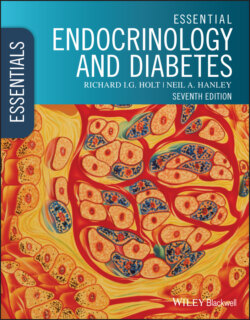Читать книгу Essential Endocrinology and Diabetes - Richard I. G. Holt - Страница 66
Growth hormone and prolactin signalling pathways – the Janus family of tyrosine kinases
ОглавлениеSimilar mechanisms govern GH and PRL receptor binding and signal transduction. The hormones are capable of binding two receptors that dimerize. The hormone–dimerized receptor unit induces conformational change in the cytoplasmic regions of the receptor and signal transduction. Discovery of this phenomenon has been utilized in drug design to combat excessive GH action in acromegaly (Figure 3.7; Chapter 5). The EPO receptor also forms homodimers, i.e. two of the same receptors that bind together. In contrast, the cytokine receptors tend to form heterodimers with diverse partner proteins.
Receptor activation by hormone binding rapidly recruits one of four members of the ‘Janus‐associated kinase’ (JAK) family of tyrosine kinases (Figure 3.8), so named after the two‐faced Roman deity, Janus, because of distinctive, tandem kinase domains at their carboxy‐terminals. GH, PRL and EPO receptor dimerization brings together JAK2 molecules that become phosphorylated. The major downstream substrates of JAK are the STAT family of proteins (explaining the term ‘JAK‐STAT’ signalling; Figure 3.8). The name STAT comes from dual function: signal transduction, located in the cytoplasm, and nuclear activation of transcription. Both activities rely on phosphorylation by JAK (Figure 3.8). Phosphorylation causes the STAT proteins to dissociate from the occupied receptor–kinase complex and dimerize themselves, which facilitates access to the nucleus. In the nucleus, dimerized STAT activates target genes, commonly those that regulate proliferation or the differentiation status of the target cell. One of the major targets of GH is the IGF‐I gene (Box 3.5). JAK signalling is not mediated exclusively via STAT. The GH receptor (GHR) also signals through MAPK and PI3‐kinase pathways. This overlap may account for some of the rapid metabolic effects of GH (Figure 3.8).
Defects in the GH signalling pathway can result in rare syndromes of resistance to GH action (Box 3.6 and Figure 3.9).
Figure 3.8 Growth hormone (GH) receptor and its signalling pathways. The receptor recruits tyrosine kinase (TK) activity from Janus‐associated kinase 2 (JAK2). Serum response elements (SREs) are mitogen‐activated protein kinase (MAPK)‐responsive regulatory elements that mediate the induction of target genes, such as c‐fos. STAT, signal transduction and activation of transcription protein; PI3 kinase, phosphatidylinositol‐3‐kinase; IRS, insulin receptor substrate.
